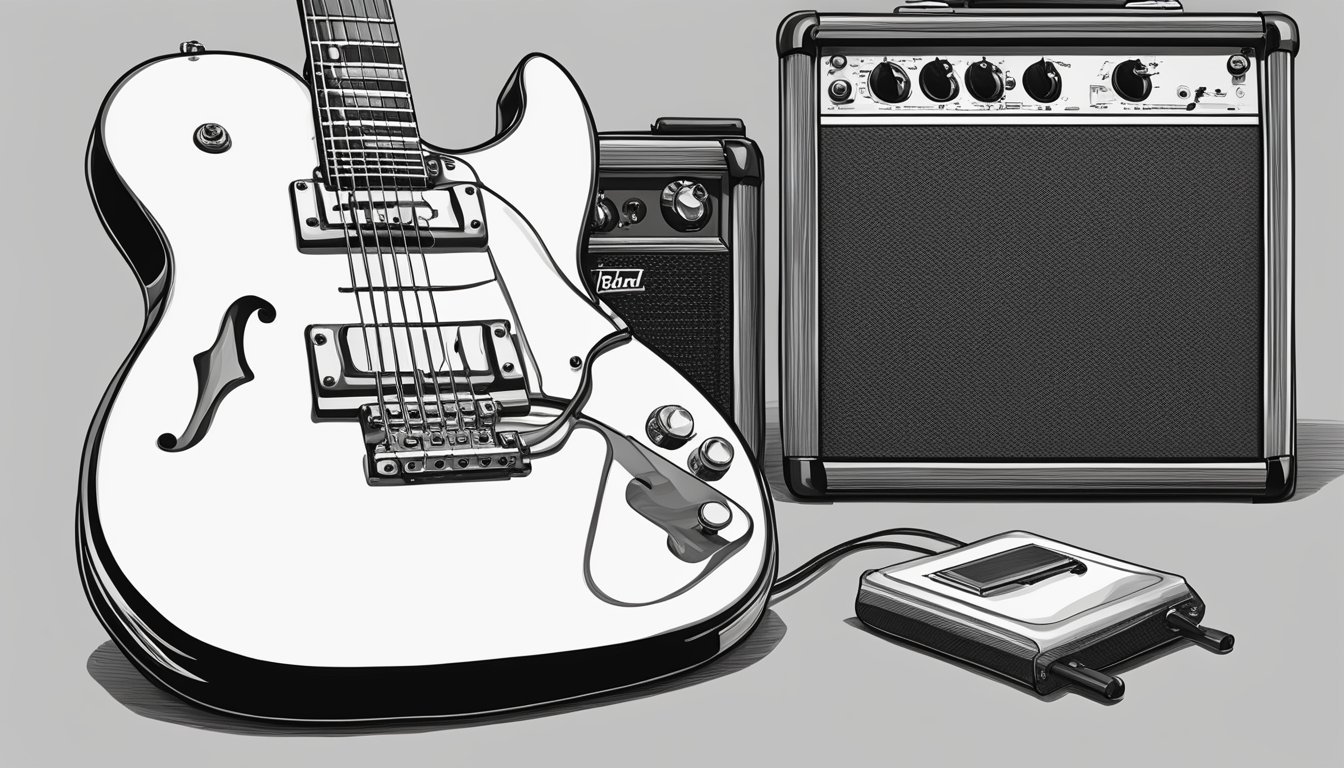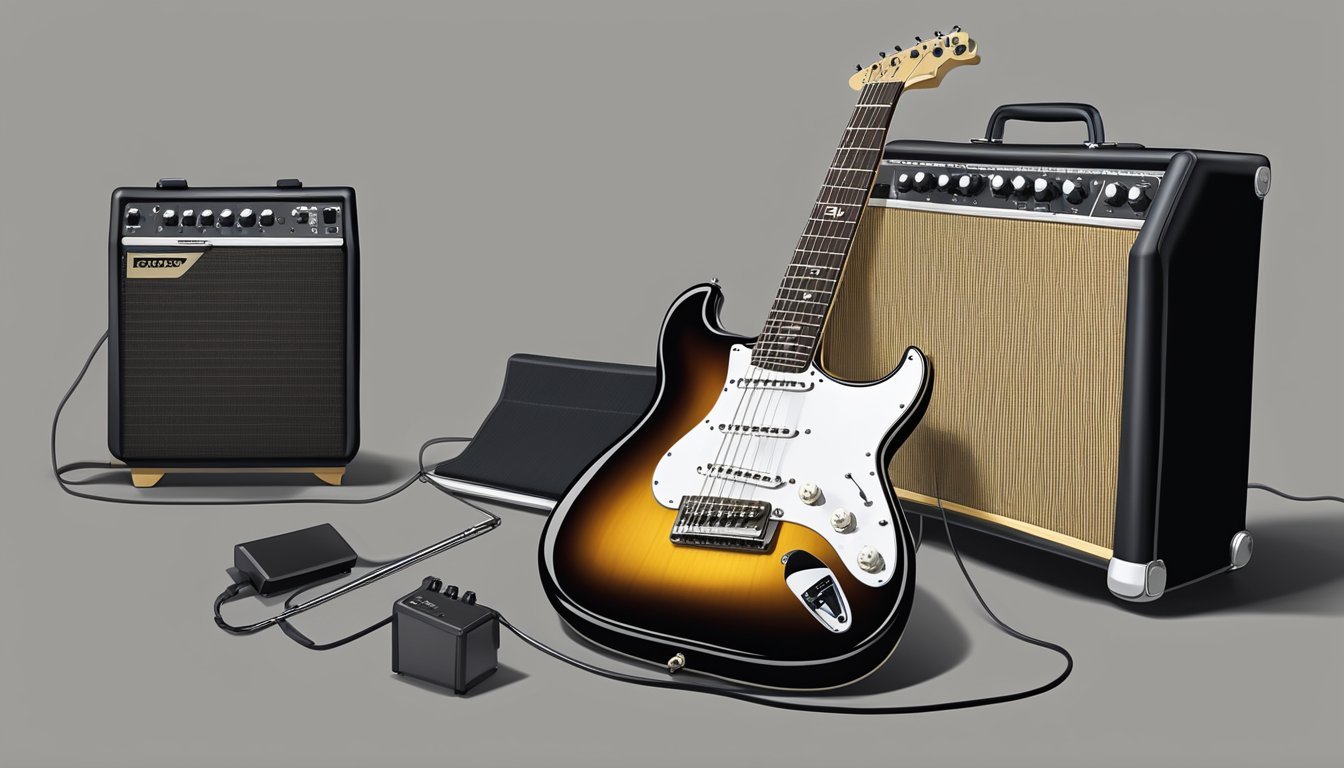Starting your electric guitar journey is exciting and rewarding. With the right approach, you can quickly learn to play your favorite songs and develop your unique sound. It’s all about finding the right resources and breaking down the steps into manageable parts.

You don’t need to be a musical genius to pick up the electric guitar.
All it takes is a bit of practice and some guidance to build your skills from the ground up.
Whether you want to jam with friends or play on stage, you’ll find that learning guitar can be both fun and fulfilling.
Key Takeaways
- Start with the right equipment to enhance your learning experience.
- Understand basic techniques to build a solid foundation.
- Keep practicing and exploring to expand your skills and creativity.
Getting Equipped
Getting started on electric guitar is all about having the right gear.
You want a solid instrument that feels good, plus a few essential accessories.
It also helps to set up a cozy practice space where you can play comfortably and stay focused.
Choosing Your First Electric Guitar
When picking your first electric guitar, consider comfort and playability.
A good starting point is a guitar with a lighter string gauge.
This makes it easier on your fingers as you learn to play.
Look for brands known for beginner-friendly guitars.
Examples include Squier, Epiphone, and Yamaha.
Try out different models to see which one feels right in your hands.
Think about the body style, too.
Solid body guitars like the Fender Stratocaster or Gibson Les Paul are popular for their sound and versatility.
Also, check if the guitar is in tune.
You may need to adjust the tuning or use a good guitar tuner to keep it sounding great.
Essential Accessories
You’ll also need some basic accessories to make playing easier.
Start with a guitar amp to boost your sound.
When selecting an amp, look for models with basic controls that let you shape your tone easily.
Don’t forget a guitar strap, so you can comfortably play while standing up.
It’s a good idea to invest in a sturdy strap to avoid any accidents.
Lastly, grab some extra guitar strings.
You will likely break a string now and then, especially as you start strumming.
Lighter strings are great for beginners since they’re easier to press down.
Setting Up Your Practice Space
Creating the right practice space can make a huge difference.
Find a quiet area where you won’t be disturbed.
Make sure there’s enough room for your amp and a comfortable chair or stool.
Keep a guitar tuner nearby.
This way, you can quickly check the tuning before you start playing.
Having your guitar in a stand can also help you keep it accessible and safe from damage.
Finally, add some personal touches like a music stand with your favorite tabs or posters that inspire you.
A welcoming space can motivate you to practice more often.
Basic Guitar Theory and Techniques
Getting started with electric guitar involves understanding some basic theory and techniques.
It’s important to grasp the fundamentals of music and how to play chords effectively.
This section will break down the key concepts that will set a solid foundation for your playing.
The Musical Alphabet and Fretboard
The musical alphabet consists of just seven letters: A, B, C, D, E, F, and G. These notes repeat as you move up the fretboard.
The fretboard is where you’ll be spending a lot of time learning, so knowing how it works is crucial.
Each fret represents a half step.
For example, if you play an A note on the 5th fret of the 6th string, the note on the 6th fret is A#.
Knowing this helps you understand scales and chord shapes better.
Try memorizing the notes on each string.
For quick reference, here’s a simple layout:
- 6th string (E): E, F, F#, G, G#, A, A#, B, C, C#, D, D#, E
- 5th string (A): A, A#, B, C, C#, D, D#, E, F, F#, G, G#
- 4th string (D): D, D#, E, F, F#, G, G#, A, A#, B, C, C#
- 3rd string (G): G, G#, A, A#, B, C, C#, D, D#, E, F, F#
- 2nd string (B): B, C, C#, D, D#, E, F, F#, G, G#, A, A#
- 1st string (E): E, F, F#, G, G#, A, A#, B, C, C#, D, D#
Mastering Chord Shapes and Progressions
To play songs, you need to learn basic chords.
Start with open chords like E, A, D, G, and C. These chords are fundamental for many popular songs.
You can use chord charts to help with finger placement.
Always aim to press down on the strings with your fingertips, which keeps other strings from being muted.
Progressions are combinations of chords in a sequence.
A common progression is G-C-D. Try switching between these smoothly.
Practice makes perfect.
Begin with simple progressions and gradually include more complex ones as you gain confidence.
Strumming and Picking 101
Strumming and picking techniques are essential for rhythm and melody on the guitar.
Start with a simple downstroke strum.
Use your pick or fingers to brush down across the strings in a smooth motion.
Once you’re comfortable, add upstrokes.
The basic pattern of down, up, down, up will give your playing a nice flow.
For picking, focus on precision.
Practice finger placement, aiming to only hit the intended strings.
You can use alternate picking, which is switching between downstrokes and upstrokes.
This skill will greatly improve your speed and accuracy as you progress.
Practical Playing Skills

Building practical playing skills is key when starting out with electric guitar.
You’ll want to learn essential chords and find ways to practice effectively.
This will help you progress and enjoy your playing even more.
Your First Chords and Songs
When beginning, you should focus on a few basic chords.
Start with the E major, A major, D major, G major, C major, and the E minor chords.
These are often called cowboy chords and are used in many songs.
Practice switching between these chords.
It can be helpful to create a list of simple songs that use these chords.
For example, “Sweet Home Alabama” uses D, C, and G chords.
As you play, you’ll build calluses on your fingertips, which helps when pressing down on the strings.
Use guitar tablature to learn new songs.
This way, you’ll see exactly where to place your fingers, making it easier to play along.
Developing Effective Practice Routines
Creating a practice routine is essential.
Start with short sessions of about 15 to 30 minutes.
As you get comfortable, you can extend your practice time.
Focus on techniques such as downstrokes and different strumming patterns.
You could create specific goals for each practice session.
For instance, spend one day working solely on chord changes and another day learning new songs.
Don’t forget to include warm-up exercises.
Simple finger exercises help improve your dexterity.
It’s all about consistency over time, so stick with it.
The more you practice, the more progress you’ll see in your playing.
Expanding Your Skills
Once you’ve got the basics down, it’s time to take your playing to the next level.
By focusing on barre and power chords, improving your strumming techniques, and using online resources, you can boost your skills and confidence.
Exploring Barre and Power Chords
Barre chords can feel tricky at first, but they’re key to expanding your chord library.
These chords require you to press down multiple strings with one finger, creating a “bar.”
Start with the F major barre chord on the first fret.
As you get comfortable, try moving it around the neck.
Power chords are another great tool.
They’re simpler and only use two or three notes.
You can often play them with just a downstroke for a strong sound.
Both types of chords open up new songs and styles.
Discovering New Strumming Techniques
Strumming techniques can greatly affect how your music sounds.
Start with the basic downstroke.
Once that feels natural, incorporate upstrokes.
This creates a groove, adding rhythm to your playing.
You can also try different patterns.
For example, try alternating downstrokes and upstrokes for a rock feel.
At the same time, experiment with palm muting.
This technique gives a sharper sound and can be effective in various genres.
Practice these techniques slowly at first.
As you improve, you’ll find it easier to add them into your playing.
Online Resources and Continued Learning
The internet is full of resources to help improve your skills.
Platforms like Fender Play offer structured lessons that guide you through different styles and techniques.
You can learn chords and even specific songs at your own pace.
Additionally, consider joining online guitar forums or communities.
These spaces are great for getting advice, sharing progress, and finding new challenges.
YouTube is also a treasure trove of tutorials and demonstrations, helping you visualize what’s being taught.
Don’t forget to set aside time each week for practice.
Consistency is key to your growth as a guitarist.
Frequently Asked Questions
When starting out with electric guitar, you might have some common questions.
Here are specific answers to help you on your journey.
Understanding how to start playing electric guitar involves getting familiar with your instrument, learning basic chords, and practicing regularly.
Additionally, utilizing online resources or taking lessons can significantly enhance your learning experience and help you progress faster.
Don’t forget to set realistic goals and be patient with yourself as you develop your skills!
What essentials do I need to begin playing electric guitar?
To start, you need an electric guitar, an amplifier, and a guitar cable.
Don’t forget a tuner to keep your guitar sounding great.
A pick can help with strumming and picking, and a comfortable strap will help you play longer sessions.
Can I start learning electric guitar without any prior music knowledge?
Absolutely! Many beginners start with no music background.
You can learn basic chords and simple songs without knowing how to read music.
Just focus on finding good resources and practice regularly.
What’s the first step to self-teaching electric guitar at home?
Begin by learning how to properly hold the guitar and tune it.
Familiarize yourself with the parts of the guitar, then start practicing basic chords.
Taking it slow with simple exercises will help you build a solid foundation.
Are there any free resources available for learning electric guitar?
Yes, there are plenty of free online resources.
Websites like YouTube offer countless tutorials.
You can also find free tabs and chord charts on various music sites, which are excellent for learning your favorite songs.
How can I effectively practice chords on an electric guitar?
Start with a few basic chords and practice switching between them smoothly.
Use a metronome to keep a steady pace.
Try strumming along with your favorite songs to make practice more enjoyable and effective.
What are the key differences between learning on acoustic and electric guitars?
Electric guitars are usually easier to press down on, which can help with learning chords.
They also have effects like distortion that can make playing more fun.
Meanwhile, acoustic guitars require more finger strength, but they help develop proper technique.

